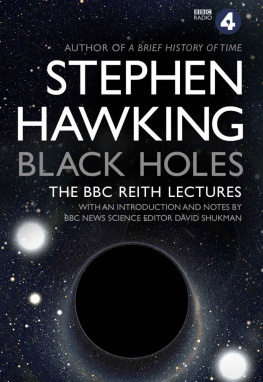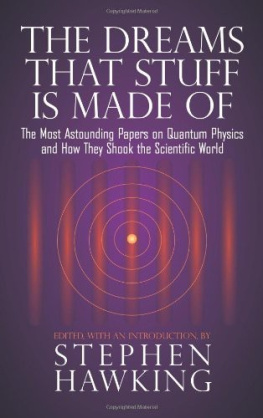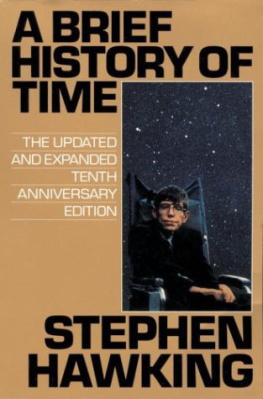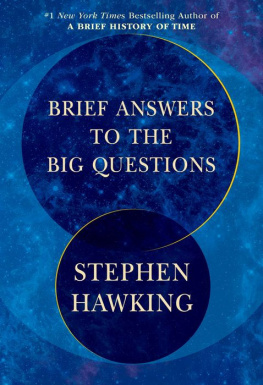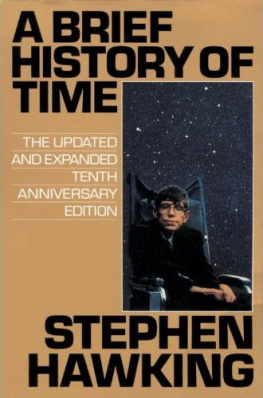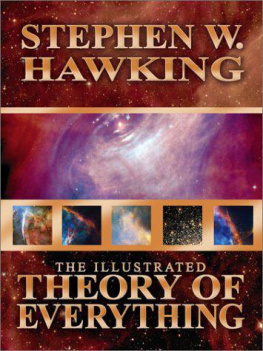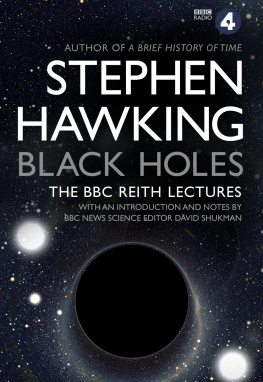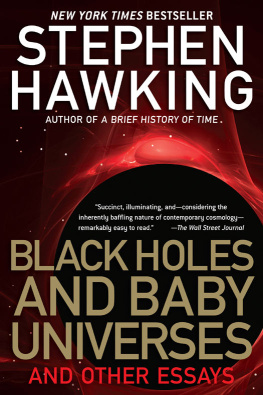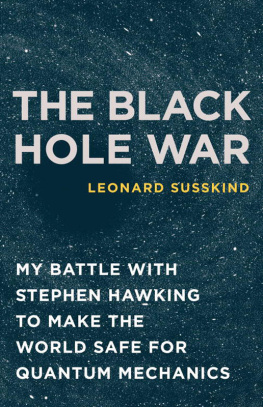Stephen Hawking - Black Holes
Here you can read online Stephen Hawking - Black Holes full text of the book (entire story) in english for free. Download pdf and epub, get meaning, cover and reviews about this ebook. year: 2016, publisher: Bantam, genre: Religion. Description of the work, (preface) as well as reviews are available. Best literature library LitArk.com created for fans of good reading and offers a wide selection of genres:
Romance novel
Science fiction
Adventure
Detective
Science
History
Home and family
Prose
Art
Politics
Computer
Non-fiction
Religion
Business
Children
Humor
Choose a favorite category and find really read worthwhile books. Enjoy immersion in the world of imagination, feel the emotions of the characters or learn something new for yourself, make an fascinating discovery.
- Book:Black Holes
- Author:
- Publisher:Bantam
- Genre:
- Year:2016
- Rating:3 / 5
- Favourites:Add to favourites
- Your mark:
- 60
- 1
- 2
- 3
- 4
- 5
Black Holes: summary, description and annotation
We offer to read an annotation, description, summary or preface (depends on what the author of the book "Black Holes" wrote himself). If you haven't found the necessary information about the book — write in the comments, we will try to find it.
Black Holes — read online for free the complete book (whole text) full work
Below is the text of the book, divided by pages. System saving the place of the last page read, allows you to conveniently read the book "Black Holes" online for free, without having to search again every time where you left off. Put a bookmark, and you can go to the page where you finished reading at any time.
Font size:
Interval:
Bookmark:
It is said that fact is sometimes stranger than fiction, and nowhere is that more true than in the case of black holes. Black holes are stranger than anything dreamed up by science-fiction writers.
In 2016 Professor Stephen Hawking delivered the BBC Reith Lectures on a subject that has fascinated him for decades black holes.
In these flagship lectures the legendary physicist argues that if we could only understand black holes and how they challenge the very nature of space and time, we would be closer to unlocking the secrets of the universe.
BBC News Science Editor David Shukman
Everything about Stephen Hawking is a source of fascination: the plight of a genius trapped in an ailing body; the hint of a smile brightening a face in which only a single muscle can move; the distinctively robotic voice inviting us to share the exhilaration of discovery as his mind roams through the strangest corners of the Universe.
Against all the odds, this remarkable figure has transcended the usual boundaries of science. His book A Brief History of Time sold a staggering ten million copies. Cameo roles in popular comedy shows, invitations to the White House and a well-received movie about his life have confirmed him as a celebrity. He has achieved nothing less than becoming the most famous scientist in the world.
In the 1960s, he was given two years to live when he was diagnosed with motor neurone disease. But more than half a century later he is still researching, writing, travelling and regularly appearing in the news. His daughter Lucy, explaining this extraordinary drive, describes him as enormously stubborn.
Whether through the pain of his personal story or his ability to enthuse, Hawking captures the imagination. He recently warned that humankind faced a series of disasters of its own making from global warming to artificially engineered viruses and an article reporting his words was the most-read on the BBC website that day.
It is a terrible irony that such a great communicator cannot have a normal conversation. For interviews, the questions have to be sent in advance. Some years ago, his staff warned me not to attempt small talk because his answers even to the briefest questions take so long to compose. In the excitement of meeting him, however, I could not resist blurting out: How are you? and then had to wait guiltily for his reply. He was fine.
In his Cambridge office, a board is covered with equations. Mathematics of the most rarefied kind is the currency of cosmology. But Stephen Hawkings unique contribution to scientific research is to harness the approaches of apparently very different specialisms: most famously, he was the first to investigate the vast realm of space using scientific techniques devised to study the tiny particles inside atoms.
His colleagues in this fiendishly complex field might fear that their work can never be made intelligible to the public. Yet striving to reach a wider audience is a Hawking trademark. In this years BBC Reith Lectures, he rose to the challenge of summarizing a lifetimes insights into black holes in two fifteen-minute talks. And for those who are curious but perplexed, or enthralled by the ideas but nervous about the science, I have added notes at key points to offer a helping hand.

IT IS SAID that fact is sometimes stranger than fiction, and nowhere is that more true than in the case of black holes. Black holes are stranger than anything dreamed up by science-fiction writers, but they are firmly matters of science fact. The scientific community was slow to realize that massive stars could collapse in on themselves, under their own gravity, and to consider how the objects left behind would behave. Albert Einstein even wrote a paper in 1939 claiming that stars could not collapse under gravity because matter could not be compressed beyond a certain point. Many scientists shared Einsteins gut feeling. The principal exception was the American scientist John Wheeler, who in many ways is the hero of the black hole story. In his work in the 1950s and 1960s, he emphasized that many stars would eventually collapse, and pointed out the problems that possibility posed for theoretical physics. He also foresaw many of the properties of the objects which collapsed stars become that is, black holes.
DS: The phrase black hole is simple enough, but its hard to imagine one out there in space. Think of a giant drain with water spiralling down into it. Once anything slips over the edge what is called the event horizon there is no way back. Because black holes are so powerful, even light gets sucked in, so we cant actually see them. But scientists know they exist because they rip apart stars that get too close to them and because they can send tremors through space.It was a collision between two black holes more than a billion years ago that triggered what are called gravitational waves, the recent detection of which was a hugely significant scientific achievement.
During most of the life of a normal star, over many billions of years, it will support itself against its own gravity by thermal pressure, caused by nuclear processes which convert hydrogen into helium.
DS: NASA describes stars as rather like pressure-cookers. The explosive force of nuclear fusion inside them creates outward pressure which is constrained by gravity pulling everything inwards.
Eventually, however, the star will exhaust its nuclear fuel. The star will now contract. In some cases, it may be able to support itself as a white dwarf star. However, Subrahmanyan Chandrasekhar showed in 1930 that the maximum mass of a white dwarf star is about 1.4 times that of the sun. A similar maximum mass was calculated by Soviet physicist Lev Landau for a star made entirely of neutrons.

DS: White dwarfs and neutron stars were once suns and have since burned up their fuel. With no force working to inflate them, nothing can stop their gravitational pull from shrinking them, and they have become some of the densest objects in the universe. But in the league-table of stars these ones are relatively small, which means they lack the gravitational strength to collapse completely. So, most interesting to Stephen Hawking and others is what happens to the very largest stars when they reach their end of their lives.
What, then, would be the fate of those countless stars with greater mass than a white dwarf or neutron star when they had exhausted their nuclear fuel? The problem was investigated by Robert Oppenheimer, of later atom bomb fame. In a couple of papers in 1939, with George Volkoff and Hartland Snyder, he showed that such a star could not be supported by outward pressure; and that, if you take pressure out of the calculation, a uniform spherically systematic symmetric star would contract to a single point of infinite density. Such a point is called a singularity.
DS: A singularity is what you end up with when a giant star is compressed to an unimaginably small point. This concept has been a defining theme in Stephen Hawkings career. It refers not only to the end of a star but also to a far more fundamental idea about the starting-point for the formation of the entire universe. It was Hawkings mathematical work on this that earned him global recognition.
Font size:
Interval:
Bookmark:
Similar books «Black Holes»
Look at similar books to Black Holes. We have selected literature similar in name and meaning in the hope of providing readers with more options to find new, interesting, not yet read works.
Discussion, reviews of the book Black Holes and just readers' own opinions. Leave your comments, write what you think about the work, its meaning or the main characters. Specify what exactly you liked and what you didn't like, and why you think so.

